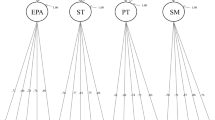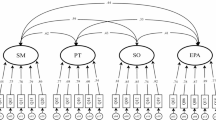Abstract
Interpersonal Emotion regulation has become an important research topic in emotional studies. In this study, we examined the psychometric properties of the interpersonal emotion regulation questionnaire (IERQ) in the nonclinical and clinical populations. Data were drawn from two studies. One study was conducted in a general population (N = 428) and the other in a clinical setting with individuals diagnosed with emotional disorders (N = 220). To assess the convergent validity of IERQ in the first study, questionnaires assessing emotion regulation, anxiety, depression, attachment style, and emotional intelligence were also conducted. Confirmatory Factor Analysis (CFA) results showed that the four-factor model of the IERQ fit the data in the nonclinical sample and emotional disorders sample well. The IERQ questionnaire showed excellent internal consistency for all subscales in the nonclinical and clinical samples. Test-retest reliability analysis also showed high levels of test-retest reliability in the nonclinical sample. The convergent validity results demonstrated the significant relationship of IERQ with almost all measures assessing emotion regulation, anxiety, depression, attachment style, and emotional intelligence. Findings of discriminant validity showed significant differences between the clinical and nonclinical population in subscales of IERQ, but there are not any significant differences between clinical groups in these subscales. The convenience sampling method was used for the first sample, and some measures could not be used in the clinical samples, and some analyses could not be conducted in this sample. Furthermore, limited emotional disorder diagnostics were included in the clinical sample, and a large number of disorders were not considered. Thus, the generalizability of our findings is limited. Overall, the current study provided evidence supporting the reliability and validity of IERQ in the Iranian community and emotional disorders samples and pave the way for further cross-cultural research on IER.


Similar content being viewed by others
References
Barker, C., Pistrang, N., & Elliott, R. (2015). Research methods in clinical psychology: An introduction for students and practitioners. John Wiley & Sons.
Beckes, L., & Coan, J. A. (2011). Social baseline theory: The role of social proximity in emotion and economy of action. Social and Personality Psychology Compass, 5(12), 976–988.
Bjelland, I., Dahl, A. A., Haug, T. T., & Neckelmann, D. (2002). The validity of the hospital anxiety and depression scale: An updated literature review. Journal of Psychosomatic Research, 52(2), 69–77.
Christensen, K. A., & Haynos, A. F. (2020). A theoretical review of interpersonal emotion regulation in eating disorders: Enhancing knowledge by bridging interpersonal and affective dysfunction. Journal of Eating Disorders, 8, 1–10.
Clarke, D. E., Narrow, W. E., Regier, D. A., Kuramoto, S. J., Kupfer, D. J., Kuhl, E. A., Greiner, L., & Kraemer, H. C. (2013). DSM-5 field trials in the United States and Canada, part I: Study design, sampling strategy, implementation, and analytic approaches. American Journal of Psychiatry, 170(1), 43–58.
Cludius, B., Mennin, D., & Ehring, T. (2020). Emotion regulation as a transdiagnostic process. Emotion, 20(1), 37–42.
Collins, N. L. (1996). Working models of attachment: Implications for explanation, emotion, and behavior. Journal of Personality and Social Psychology, 71(4), 810–832.
d’Arbeloff, T. C., Kim, M. J., Knodt, A. R., Radtke, S. R., Brigidi, B. D., & Hariri, A. R. (2018). Microstructural integrity of a pathway connecting the prefrontal cortex and amygdala moderates the association between cognitive reappraisal and negative emotions. Emotion, 18(6), 912.
Dingle, G. A., Neves, D. D. C., Alhadad, S. S., & Hides, L. (2018). Individual and interpersonal emotion regulation among adults with substance use disorders and matched controls. British Journal of Clinical Psychology, 57(2), 186–202.
Dixon-Gordon, K. L., Bernecker, S. L., & Christensen, K. (2015). Recent innovations in the field of interpersonal emotion regulation. Current Opinion in Psychology, 3, 36–42.
Dixon-Gordon, K. L., Haliczer, L. A., Conkey, L. C., & Whalen, D. J. (2018). Difficulties in interpersonal emotion regulation: Initial development and validation of a self-report measure. Journal of Psychopathology and Behavioral Assessment, 40(3), 528–549.
Eisenberg, N., Spinrad, T. L., & Eggum, N. D. (2010). Emotion-related self-regulation and its relation to children's maladjustment. Annual Review of Clinical Psychology, 6, 495–525.
English, T., Lee, I. A., John, O. P., & Gross, J. J. (2017). Emotion regulation strategy selection in daily life: The role of social context and goals. Motivation and Emotion, 41(2), 230–242.
George, D., & Mallery, P. (2003). Frequencies. SPSS for Windows step by step: A simple guide and reference, 11.0 update.
Gratz, K. L., & Roemer, L. (2004). Multidimensional assessment of emotion regulation and dysregulation: Development, factor structure, and initial validation of the difficulties in emotion regulation scale. Journal of Psychopathology and Behavioral Assessment, 26(1), 41–54.
Gross, J. J. (2013). Handbook of emotion regulation. Guilford publications.
Gross, J. J., & John, O. P. (2003). Individual differences in two emotion regulation processes: Implications for affect, relationships, and well-being. Journal of Personality and Social Psychology, 85(2), 348–362.
Gross, J. J., & Thompson, R. A. (2007). Emotion regulation: Conceptual foundations. Handbook of Emotion Regulation, pp. 3–24.
Gruhn, M. A., & Compas, B. E. (2020). Effects of maltreatment on coping and emotion regulation in childhood and adolescence: A meta-analytic review. Child Abuse & Neglect, 103, 104446.
Hasani, J. (2016). Persian version of the emotion regulation questionnaire: Factor structure, reliability and validity. International Journal of Behavioral Sciences, 10(3), 156–161.
Higgins, E. T., & Pittman, T. S. (2008). Motives of the human animal: Comprehending, managing, and sharing inner states. Annual Review of Psychology, 59, 361–385.
Hofmann, S. G. (2014). Interpersonal emotion regulation model of mood and anxiety disorders. Cognitive Therapy and Research, 38(5), 483–492.
Hofmann, S. G., Carpenter, J. K., & Curtiss, J. (2016). Interpersonal emotion regulation questionnaire (IERQ): Scale development and psychometric characteristics. Cognitive Therapy and Research, 40(3), 341–356.
Koç, M. S., Aka, B. T., Doğruyol, B., Curtiss, J., Carpenter, J. K., & Hofmann, S. G. (2019). Psychometric properties of the Turkish version of the interpersonal emotion regulation questionnaire (IERQ). Journal of Psychopathology and Behavioral Assessment, 41(2), 294–303.
Levy-Gigi, E., & Shamay-Tsoory, S. G. (2017). Help me if you can: Evaluating the effectiveness of interpersonal compared to intrapersonal emotion regulation in reducing distress. Journal of Behavior Therapy and Experimental Psychiatry, 55, 33–40.
Liddell, B. J., & Williams, E. N. (2019). Cultural differences in interpersonal emotion regulation. Frontiers in Psychology, 10, 999.
López-Pérez, B., Ambrona, T., & Gummerum, M. (2017). Interpersonal emotion regulation in Asperger's syndrome and borderline personality disorder. British Journal of Clinical Psychology, 56(1), 103–113.
Marroquín, B. (2011). Interpersonal emotion regulation as a mechanism of social support in depression. Clinical Psychology Review, 31(8), 1276–1290.
Mazaheri, M. (2015). Psychometric properties of the persian version of the difficulties in emotion regulation scale DERS-6 & DERS-5-revised (in an Iranian clinical sample. Iranian Journal of Psychiatry, 10(2), 115, 122.
McRae, K. (2016). Cognitive emotion regulation: A review of theory and scientific findings. Current Opinion in Behavioral Sciences, 10, 119–124.
Meyers, L. S., Gamst, G., & Guarino, A. J. (2016). Applied multivariate research: Design and interpretation. Sage publications.
Mohammadkhani, P., Forouzan, A. S., Hooshyari, Z., & Abasi, I. (2020). Psychometric properties of Persian version of structured clinical interview for DSM-5-research version (SCID-5-RV): A diagnostic accuracy study [research article]. Iran J Psychiatry Behav Sci, 14(2), e100930. https://doi.org/10.5812/ijpbs.100930
Montazeri, A., Vahdaninia, M., Ebrahimi, M., & Jarvandi, S. (2003). The hospital anxiety and depression scale (HADS): Translation and validation study of the Iranian version. Health and Quality of Life Outcomes, 1(1), 14.
Mukaka, M. M. (2012). A guide to appropriate use of correlation coefficient in medical research. Malawi Medical Journal, 24(3), 69–71.
Niven, K., Totterdell, P., Stride, C. B., & Holman, D. (2011). Emotion regulation of others and self (EROS): The development and validation of a new individual difference measure. Current Psychology, 30(1), 53–73.
Peters, B. J., Overall, N. C., & Jamieson, J. P. (2014). Physiological and cognitive consequences of suppressing and expressing emotion in dyadic interactions. International Journal of Psychophysiology, 94(1), 100–107.
Petrides, K. V. (2009). Psychometric properties of the trait emotional intelligence questionnaire (TEIQue). In assessing emotional intelligence (pp. 85–101). Springer.
Pruessner, L., Barnow, S., Holt, D. V., Joormann, J., & Schulze, K. (2020). A cognitive control framework for understanding emotion regulation flexibility. Emotion, 20(1), 21–29.
Rahimi, M. (2021). Psychometric properties of the persian trait emotional intelligence questionnaire (P-TEIQue). Current Psychology, 40(6), 2778–2785.
Regier, D. A., Narrow, W. E., Clarke, D. E., Kraemer, H. C., Kuramoto, S. J., Kuhl, E. A., & Kupfer, D. J. (2013). DSM-5 field trials in the United States and Canada, part II: Test-retest reliability of selected categorical diagnoses. American Journal of Psychiatry, 170(1), 59–70.
Serafini, G., Canepa, G., Adavastro, G., Nebbia, J., Belvederi Murri, M., Erbuto, D., Pocai, B., Fiorillo, A., Pompili, M., & Flouri, E. (2017). The relationship between childhood maltreatment and non-suicidal self-injury: A systematic review. Frontiers in Psychiatry, 8, 149.
Serafini, G., Gonda, X., Pompili, M., Rihmer, Z., Amore, M., & Engel-Yeger, B. (2016). The relationship between sensory processing patterns, alexithymia, traumatic childhood experiences, and quality of life among patients with unipolar and bipolar disorders. Child Abuse & Neglect, 62, 39–50.
Vahedi, S., Badri Gargari, R., & Gholami, S. (2016). Mediating role of cognitive emotion regulation strategies on the relationship between the attachment styles and emotional problems: A path analysis. Iranian J Psych Behav Sci, 10(4), e4013.
Walker, J., & Almond, P. (2010). Interpreting statistical findings: A guide for health professionals and students. McGraw-hill education (UK).
Wang, J., Mann, F., Lloyd-Evans, B., Ma, R., & Johnson, S. (2018). Associations between loneliness and perceived social support and outcomes of mental health problems: A systematic review. BMC Psychiatry, 18(1), 156.
Zaki, J., & Williams, W. C. (2013). Interpersonal emotion regulation. Emotion, 13(5), 803–810.
Zigmond, A. S., & Snaith, R. P. (1983). The hospital anxiety and depression scale. Acta Psychiatrica Scandinavica, 67(6), 361–370.
Acknowledgements
Many thanks for those participants who participated in this study.
Author information
Authors and Affiliations
Corresponding author
Additional information
Publisher’s Note
Springer Nature remains neutral with regard to jurisdictional claims in published maps and institutional affiliations.
Rights and permissions
About this article
Cite this article
Abasi, I., Hofmann, S.G., Kamjou, S. et al. Psychometric properties of interpersonal emotion regulation questionnaire in nonclinical and clinical population in Iran. Curr Psychol 42, 8356–8366 (2023). https://doi.org/10.1007/s12144-021-02191-8
Accepted:
Published:
Issue Date:
DOI: https://doi.org/10.1007/s12144-021-02191-8




